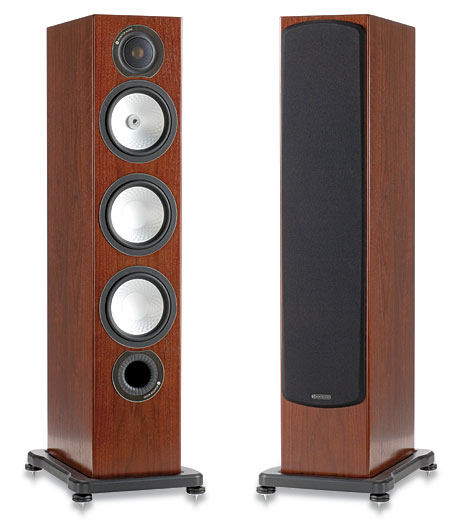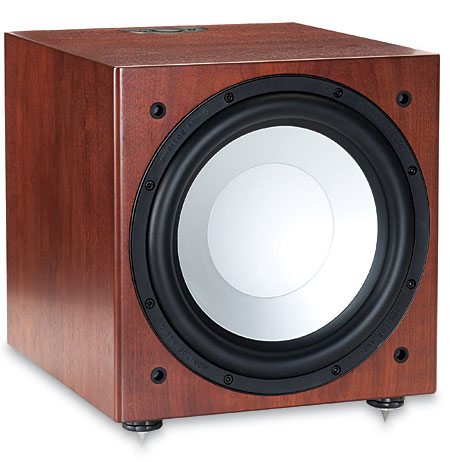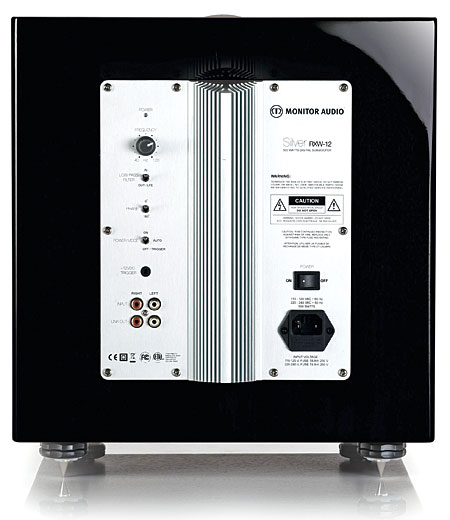Monitor Audio Silver RX8 Speaker System

Bringing Home the Silver
One benefit that comes from the development of flagship products like Monitor Audio’s Platinum PL300-based speaker system (HT, October 2009) is that the technology often filters down into less expensive models in the manufacturer’s line. Of course, it won’t surprise you to hear that the ribbon tweeters, sculpted cabinets, and leather trim found in that $25,000-plus Platinum set haven’t made it into the $4,400 Silver RX8 system under review here. But refinement, elegance, and most importantly, high value and superb performance are still very much part of the package.
Silvered Cones and Golden Domes
Like all of Monitor Audio’s speakers, the Silver RX models are engineered in Monitor’s facilities in the U.K. and manufactured at the company’s plant in China. The gorgeous Rosenut veneer on our samples is the best simulation
of genuine rosewood I’ve ever seen. Magnets buried beneath the veneer hold the grilles in place, so there’s no visible grille-attachment hardware.
Looks matter, but more impor- tantly, the Silver RX’s high-tech genes are evident from the first look at their front baffles. The cones in all of the woofers and midrange drivers are made of C-CAM and use Monitor Audio’s Rigid Surface Technology (RST) cone profiles. With variations, Monitor has used C-CAM in all of its premium speakers over the past few years. It was first developed for turbine blades in jet engines. C-CAM is an alloy of aluminum and magnesium coated under high temperature with a thin layer of pure ceramic (alumina). The result is a strong, rigid, low-mass structure half the thickness of a human hair. The cones also have small, golf-ball-like dimples in their surfaces for additional stiffness. The silver-bullet dust caps at the drivers’ centers resemble phase plugs, but they move with the cone. True phase plugs are fixed to the pole piece at the center of the voice coil and remain stationary while the cone moves around them.

The tweeter diaphragms are also made of C-CAM. They have a golden appearance but are not made of real gold. (Gold would be too heavy and soft for a tweeter, I would think, even in a thin coating.) Instead, it’s simply a color that Monitor applies during the anodizing process. A touch of golden color on the tweeters is a trademark of Monitor Audio speakers. The company has only broken this chain with the ribbon tweeters in its Platinum line.
Whereas most speakers use screws or bolts to hold the drivers in place from the front, the RX series uses threaded rods that screw into threaded holes at the back of each woofer and mid- range driver. These rods extend to the rear of the cabinet, where connector bolts firmly fasten them. You can see the bolt heads on the back panel. The rods and bolts securely anchor the drivers to the cabinet. At the same time, they act as braces to increase the cabinet’s rigidity.
Two sets of terminals on the back of each full-range speaker let you biwire or biamp the speaker. The plinth at the bottom of the RX8 provides stability for the narrow cabinet. Its feet come with either spikes or soft protective pads. These pads are removable and fell off easily when I moved the speaker around and into position. It’s easy to put them back on, provided you don’t lose them. Monitor Audio might want to consider packing a few extra pads with each speaker.
Apart from the RX Centre and the RXW-12 subwoofer, the Sil- ver RX speakers all are ported. According to Monitor Audio, the three-way RX8’s drivers are specified to cross over at 300 hertz and 2.2 kilohertz, while the RX1’s woofer-to-tweeter transition is at 3 kHz. The RX Centre is a 2.5-way design, and both of its woofers operate up to 500 Hz. One of them rolls off above this, while the other continues on to meet the tweeter at 2.2 kHz.

The Silver RXW-12 subwoofer is a small but impressive beast with a 12-inch C-CAM-coned driver and a 500-watt RMS (1,000 watts peak) Class D amplifier. It offers all of the usual features: Phase, Power Mode (On/Off/Auto), Frequency (low pass from 40 Hz to 120 Hz, defeatable via a Low Pass Filter switch), a 12-volt trigger, and line-level stereo inputs and outputs. The latter are pass- through only. The sub doesn’t have high-pass filters; that’s a job for your A/V receiver or surround processor. The Level control is conveniently located on top, along with two EQ options: EQ1 and EQ2. Monitor says that EQ1 provides response to 27 Hz at an unspecified down point. EQ2 is similarly specified to reach 21 Hz.
Setup
I positioned the RX8s about 9 feet apart to the left and right of my projection screen. I toed them in toward the main listening position in my 26-by-15.5-by-8-foot home theater studio. When music was on the program, I retracted the projection screen. I placed the
RX Centre on a low stand below the screen and set up the RX1 surrounds on stands in the back of the room. I located the subwoofer behind the center speaker. All of the front speakers were 2 feet or more (mostly more) from any adjoining walls, and they fired down the long dimension of the room. The seating position was about 10 feet from the plane of the speakers.
Small changes to toe-in and tilt resulted in subtle but meaning- ful changes in the RX8’s overall balance. I got the best results with a small tilt back (just enough that I couldn’t see the top of the speaker from my center listening seat) and enough toe-in so that I could just see the far sides of the left and right enclosures.

I didn’t biamp the speakers or use spikes, and I removed the grilles. My review system also included a Parasound Halo A51 amplifier, Integra DTC-9.8 surround processor, Pioneer BDP-320 (for Blu-ray) and Pioneer Elite DV-79AVi (for CD) players, and vintage cables from Monster Cable, Cardas, and Kimber.
Listening: Two-Channel Music
My in-room measurements indicated that the RX8 exhibited an abrupt peak in its response from about 80 Hz to 100 Hz and dropped off rapidly below about 60 Hz. With the RXW-12 sub crossed over at 80 Hz, this upper-bass peak was a bit less aggressive, but it was still prominent. With the sub dialed in and set to EQ2, the low end extended down to a clean 25 Hz. Although the response was clearly well into its bottom-end rolloff by that point, I didn’t hear any sign of doubling. Doubling is second-harmonic distortion where an overdriven driver produces twice the input frequency. This doubled frequency is often high enough in level to mask the fundamental.
- Log in or register to post comments






























































